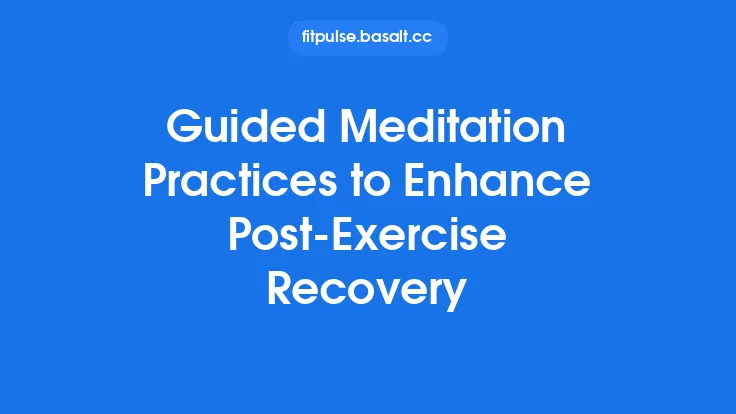Body‑scan meditation is a simple yet powerful mindfulness practice that trains the mind to notice subtle sensations throughout the body. When applied deliberately to a home workout routine, it can sharpen proprioceptive awareness, correct alignment, and sustain concentration even during the most demanding sets. Below is a comprehensive guide that walks you through the theory, step‑by‑step techniques, and practical applications of body‑scan meditation for improving exercise form and focus.
Understanding the Body Scan: What It Is and Why It Works
Definition
A body scan is a systematic, non‑judgmental observation of physical sensations—from the tips of the toes to the crown of the head. Unlike a quick “check‑in,” a full scan moves slowly, allowing the practitioner to notice temperature, pressure, tension, and movement quality in each region.
Neuroscientific Basis
- Somatosensory Cortex Activation: The scan repeatedly engages the somatosensory cortex, strengthening the neural pathways that map body parts to conscious perception.
- Prefrontal‑Cerebellar Loop: By directing attention to bodily feedback, the prefrontal cortex (executive control) and cerebellum (motor coordination) communicate more efficiently, leading to better motor planning and error correction.
- Default Mode Network (DMN) Suppression: Focused attention reduces DMN activity, which is associated with mind‑wandering and distraction, thereby increasing present‑moment awareness during exercise.
Key Benefits for Home Workouts
- Improved Form – Detecting micro‑misalignments before they become ingrained habits.
- Enhanced Kinesthetic Memory – Reinforcing the brain’s “muscle memory” through repeated sensory feedback.
- Sustained Concentration – Minimizing mental drift during long sets or circuits.
- Injury Prevention – Early identification of undue tension or compensatory patterns.
Preparing for a Body‑Scan‑Enhanced Workout
Environment
- Choose a quiet corner of your home where you can move freely.
- Use a non‑slippery surface (e.g., yoga mat, rubber flooring) to ensure stable footing.
Equipment
- A timer or meditation app with a gentle chime (optional).
- A lightweight notebook or digital log for post‑session reflections.
Physical Warm‑Up (Brief, Non‑Meditative)
- 3–5 minutes of dynamic movements (leg swings, arm circles) to raise core temperature.
- The warm‑up should be functional, not a mindfulness practice, to keep the focus on preparing the muscles rather than the mind.
Step‑by‑Step Body Scan Procedure
- Set an Intention
- Before you begin, state a clear purpose: “I will notice any tension in my shoulders while performing push‑ups.”
- This mental cue primes the brain to look for specific feedback.
- Adopt a Neutral Posture
- Stand or sit with a straight spine, shoulders relaxed, and feet hip‑width apart.
- Close your eyes if comfortable; otherwise, keep a soft gaze downward.
- Begin at the Feet
- Direct attention to the soles, noticing pressure against the floor, temperature, and any tingling.
- Spend 3–5 breaths (or ~10 seconds) here before moving upward.
- Progress Upward Systematically
- Ankles → Calves → Knees → Thighs → Pelvis → Lower Back → Abdomen → Chest → Upper Back → Shoulders → Arms → Hands → Neck → Face.
- At each segment, ask: “What sensations are present? Is there tightness, ease, or neutrality?”
- Label, Don’t Judge
- Use neutral language: “tightness,” “warmth,” “heaviness.”
- Avoid labeling sensations as “good” or “bad,” which can create mental resistance.
- Integrate Breath Lightly
- While the focus is on sensation, a natural, unforced breath supports the flow of attention.
- Do not deliberately alter the breath pattern; simply observe its rhythm.
- Conclude with a Whole‑Body Sweep
- After reaching the head, reverse direction, scanning from the crown back down to the feet.
- This reinforces a holistic sense of bodily integration.
Timing
- A full scan typically lasts 5–10 minutes. For a workout, you may perform a mini‑scan (30–60 seconds) before each exercise set, focusing only on the body parts most involved in that movement.
Applying the Scan to Specific Exercise Modalities
1. Strength Training (e.g., Dumbbell Squats, Deadlifts)
- Pre‑Set Mini‑Scan: Focus on the feet, knees, hips, and lower back. Notice any asymmetry in weight distribution.
- During the Set: Briefly pause at the bottom of the movement (if safe) to re‑check hip hinge and spinal alignment.
- Post‑Set Reflection: Write down any sensations of “over‑arching” or “collapsing” that occurred, then adjust the next set accordingly.
2. Bodyweight Calisthenics (e.g., Push‑Ups, Pull‑Ups)
- Shoulder & Scapular Scan: Prior to each set, sense the position of the scapulae—are they protracted, retracted, or neutral?
- Mid‑Movement Check: During a push‑up, pause at the lowest point (if possible) and feel the engagement of the core and chest.
3. Cardio Intervals (e.g., Jump Rope, High‑Knee Runs)
- Dynamic Scan: While moving, maintain a “soft” awareness of foot strike and knee alignment.
- Micro‑Adjustments: If you notice excessive impact on the heels, subtly shift to a mid‑foot landing.
4. Flexibility/ Mobility Drills (e.g., Hip Openers, Thoracic Rotations)
- Depth Scan: As you move deeper into a stretch, notice the gradual release of tension versus the onset of discomfort.
- Safety Cue: If a sharp, localized pain appears, the scan will alert you to stop before injury occurs.
Building a Consistent Body‑Scan Routine
| Phase | Frequency | Duration | Focus |
|---|---|---|---|
| Pre‑Workout Mini‑Scan | Every workout | 30–60 s | Targeted muscle groups |
| Full Body Scan | 2–3 times per week (e.g., on rest days) | 5–10 min | Overall proprioceptive mapping |
| Post‑Set Quick Check | After each set | 5–10 s | Immediate form correction |
| Post‑Workout Reflection | After each session | 2–3 min | Log sensations, note patterns |
Progression Tips
- Start Simple: Use the full scan only on days when you have extra time.
- Add Layers: Once comfortable, incorporate a “quality rating” (1–5) for each body region to track changes over weeks.
- Integrate Technology: Some wearable devices provide haptic feedback for posture; use them as an adjunct, not a replacement, for the mental scan.
Troubleshooting Common Challenges
| Issue | Possible Cause | Solution |
|---|---|---|
| Mind wanders after a few seconds | Over‑reliance on breath control | Gently bring attention back to the next body part without trying to force concentration. |
| Persistent tension in a region (e.g., shoulders) | Chronic postural habit or tight fascia | Combine the scan with targeted self‑myofascial release (e.g., foam rolling) outside the meditation window. |
| Difficulty distinguishing sensations | Low interoceptive awareness | Practice a daily 5‑minute “sensory check‑in” while seated, focusing solely on internal cues. |
| Feeling “stiff” during scans | Inadequate warm‑up | Add a brief dynamic mobility circuit before the first scan of the day. |
| Discomfort when pausing mid‑movement | Unsafe execution of pause | Use only safe positions (e.g., bottom of a squat with a stable base) or replace pause with a mental “snapshot” of the position. |
Measuring the Impact: Objective and Subjective Metrics
- Form Video Analysis
- Record a set before and after a 4‑week body‑scan integration. Compare alignment markers (e.g., knee over toe, neutral spine).
- Performance Indicators
- Track repetitions, weight lifted, or time under tension. Improvements often accompany better form.
- Perceived Concentration Scale
- Rate focus on a 1–10 scale after each workout. Look for upward trends.
- Pain/Discomfort Log
- Note any reduction in joint pain or muscle soreness over time.
- Interoceptive Accuracy Tests
- Simple tasks like “heartbeat detection” can be performed monthly to gauge heightened body awareness.
Integrating Body‑Scan Meditation into a Holistic Home‑Exercise Lifestyle
- Pair with Structured Programming: Use the scan as a “quality control” layer on top of any strength or cardio program you follow.
- Mindful Transitions: Between exercises, perform a 10‑second scan to reset focus before moving to the next movement.
- Community Accountability: Share your scan observations with a workout buddy or online group to reinforce consistency.
- Adapt for All Levels: Beginners may start with a 30‑second scan focusing on the core; advanced athletes can expand to a full‑body scan with nuanced sensation labeling.
Frequently Asked Questions
Q: Do I need to sit cross‑legged or adopt a specific posture for the scan?
A: No. The scan can be performed standing, seated, or even lying down, as long as you can comfortably shift attention through the body parts involved in your upcoming exercise.
Q: Can I combine the body scan with music?
A: Yes, but choose instrumental or low‑tempo tracks that do not compete for auditory attention. The goal is to keep the primary focus on internal sensations.
Q: How does the body scan differ from “mindful breathing” during workouts?
A: While mindful breathing centers on the rhythm of inhalation and exhalation, the body scan emphasizes tactile and proprioceptive feedback across the entire musculature and joints. The two can coexist, but the scan does not require deliberate breath manipulation.
Q: Is the body scan suitable for high‑intensity interval training (HIIT)?
A: Absolutely, but use brief “micro‑scans” (10–15 seconds) during the rest intervals to quickly assess form and readiness for the next burst.
Q: Will the scan replace the need for a trainer or video feedback?
A: No. The scan is a complementary tool that enhances self‑awareness. External feedback from a trainer or video remains valuable for objective correction.
Final Thoughts
Incorporating body‑scan meditation into your home workout routine transforms a purely physical activity into a mind‑body practice that cultivates precision, safety, and sustained focus. By systematically tuning into the subtle language of your muscles, joints, and connective tissue, you empower yourself to correct form in real time, deepen kinesthetic memory, and ultimately achieve more efficient, enjoyable, and injury‑free training sessions. Start with a few minutes each day, track your observations, and let the heightened awareness guide you toward consistently better performance—right in the comfort of your own home.





